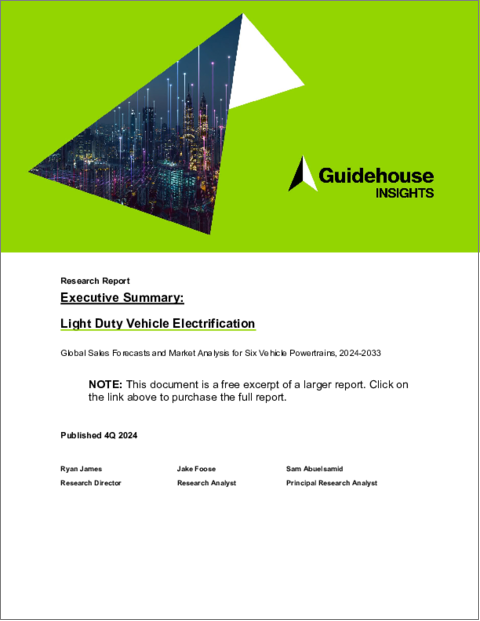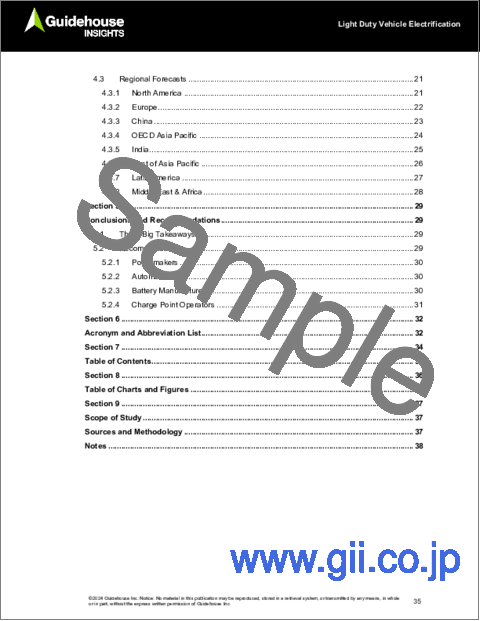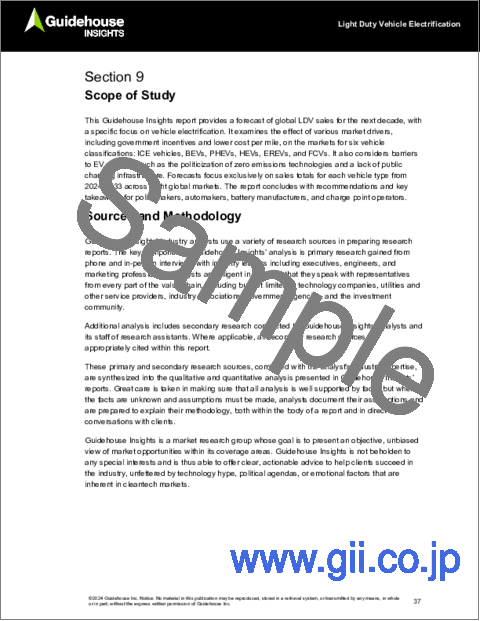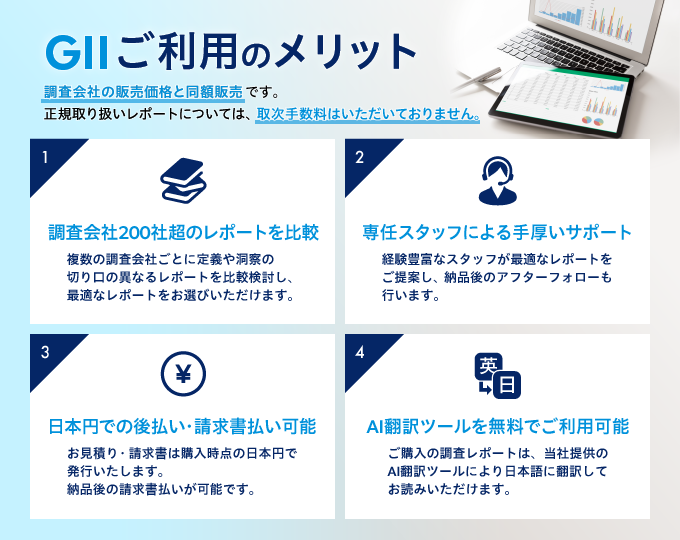|
|
市場調査レポート
商品コード
1642861
小型車の電動化:6車種のパワートレインの世界の販売予測・市場分析 (2024-2033年)Light Duty Vehicle Electrification: Global Sales Forecasts and Market Analysis for Six Vehicle Powertrains, 2024-2033 |
||||||
|
|||||||
| 小型車の電動化:6車種のパワートレインの世界の販売予測・市場分析 (2024-2033年) |
|
出版日: 2024年12月23日
発行: Guidehouse Research
ページ情報: 英文 39 Pages
納期: 即納可能
|
全表示
- 概要
- 目次
EVは自動車業界において恒久的な地位を確立すると期待されています。1800年代に発明されたEVは、2000年代にGeneral MotorsのEV1やTeslaのRoadsterによって再び世界の注目を集めました。その後、バッテリーの化学物質や製造技術の進歩とともにEVは進化してきたが、自動車の電動化も大きく多様化しています。ハイブリッドEVは、2000年代初頭にToyotaのPriusによって世界的に普及しました。
2000年初頭にToyotaのPriusによって世界的に普及したハイブリッドEV は、技術の向上により、いくつかの車両サイズでハイブリッド化が選択肢となり、より現実的なものとなっています。プラグインハイブリッドEVは、技術的には1900年代初頭に導入されましたが、2010年代まで実用化されていませんでした。航続距離延長型EV (EREV) もChevy Voltの時代から復活しつつあります。EREVは、牽引車やオフロード走行用に設計された車両にとって特に価値が高く、中国で大きな反響を呼んでおり、今後10年間に他の市場でも同様の反響が広がると予想されています。
本レポートでは、世界の小型車の電動化について調査し、ICE、BEV、PHEV、HEV、EREV、FCVの6種類のパワートレインについて、今後10年間の世界8地域での販売台数の予測と市場シェアを調査しています。
目次
第1章 エグゼクティブサマリー
- 市場概要
- 市場予測
第2章 市場の問題
- 促進要因
- 脱炭素化目標
- 燃料費とメンテナンス費の削減
- 電動化の選択肢の拡大
- 障壁
- 充電インフラの不足
- 不確実な総所有コスト
- 複雑または過度に制限的な政府のインセンティブ
- 環境目標の政治化
- 電池の価格設定とその他のビジネス上の問題
第3章 産業バリューチェーン
- 競合情勢
- ビジネスモデルの進化
第4章 市場予測
- 定義と調査手法
- 世界の予測
- 内燃機関車
- バッテリーEV
- プラグインハイブリッドEV
- ハイブリッドEV
- 航続距離延長型EV
- 燃料電池自動車
- 地域予測
- 北米
- 欧州
- 中国
- アジア太平洋OECD諸国
- インド
- その他のアジア太平洋地域
- ラテンアメリカ
- 中東・アフリカ
第5章 総論・提言
- 3項目の主な要点
- 推奨事項
- 政策立案者
- 自動車製造業者
- 電池製造業者
- チャージポイントオペレーター
第6章 頭字語・略語一覧
第7章 目次
第8章 図表
第9章 調査範囲・情報源と調査手法・注記
EVs are expected to have a permanent place in the vehicle landscape. After being initially invented in the 1800s, the EV reemerged into the global consciousness in the 2000s with General Motors' (GM's) EV1 and the Tesla Roadster. While the EV has since evolved as battery chemistries and manufacturing techniques have advanced, vehicle electrification has diversified significantly as well. Hybrid EVs (HEVs), popularized globally by the Toyota Prius in the early 2000s, have become
more viable as the technology has improved to make hybridization an option for several vehicle sizes. Plug-in hybrid EVs (PHEVs), technically introduced in the early 1900s but not practical until the 2010s, have been letting many drivers make their daily commute with zero emissions. Extended range EVs (EREVs) have also been making a comeback since the days of the Chevy Volt. Particularly valuablefor vehicles designed for towing or off-road driving, EREVs have been making big waves in China and are expected to do the same in other markets in the coming decade.
This report evaluates the global light duty vehicle (LDV) market with a specific focus on the multiple electrification options that Guidehouse Insights forecasts will make up the entirety of the market in the coming decade. It looks at expected sales and market share for six different LDV powertrains-internal combustion engine (ICE) vehicles, battery EVs (BEVs), PHEVs, HEVs, EREVs, and hydrogen fuel cell vehicles (FCVs)-in eight global regions over the next 10 years.
Table of Contents
1. Executive Summary
- 1.1 Market Overview
- 1.2 Market Forecasts
2. Market Issues
- 2.1 Drivers
- 2.1.1 Decarbonization Goals
- 2.1.2 Lower Fuel and Maintenance Costs
- 2.1.3 Expanded Electrification Choices
- 2.2 Barriers
- 2.2.1 Lack of Charging Infrastructure
- 2.2.2 Uncertain Total Cost of Ownership
- 2.2.3 Complex or Overly Restrictive Government Incentives
- 2.2.4 Politicization of Environmental Goals
- 2.3 Battery Pricing and Other Business Issues
3. Industry Value Chain
- 3.1 Competitive Landscape
- 3.1.1 Business Model Evolution
4. Market Forecasts
- 4.1 Definitions and Methodology
- 4.2 Global Forecasts
- 4.2.1 ICE Vehicles
- 4.2.2 Battery EVs
- 4.2.3 Plug-In Hybrid EVs
- 4.2.4 Hybrid EVs
- 4.2.5 Extended Range EVs
- 4.2.6 Fuel Cell Vehicles
- 4.3 Regional Forecasts
- 4.3.1 North America
- 4.3.2 Europe
- 4.3.3 China
- 4.3.4 OECD Asia Pacific
- 4.3.5 India
- 4.3.6 Rest of Asia Pacific
- 4.3.7 Latin America
- 4.3.8 Middle East & Africa
5. Conclusions and Recommendations
- 5.1 Three Big Takeaways
- 5.2 Recommendations
- 5.2.1 Policymakers
- 5.2.2 Automakers
- 5.2.3 Battery Manufacturers
- 5.2.4 Charge Point Operators





